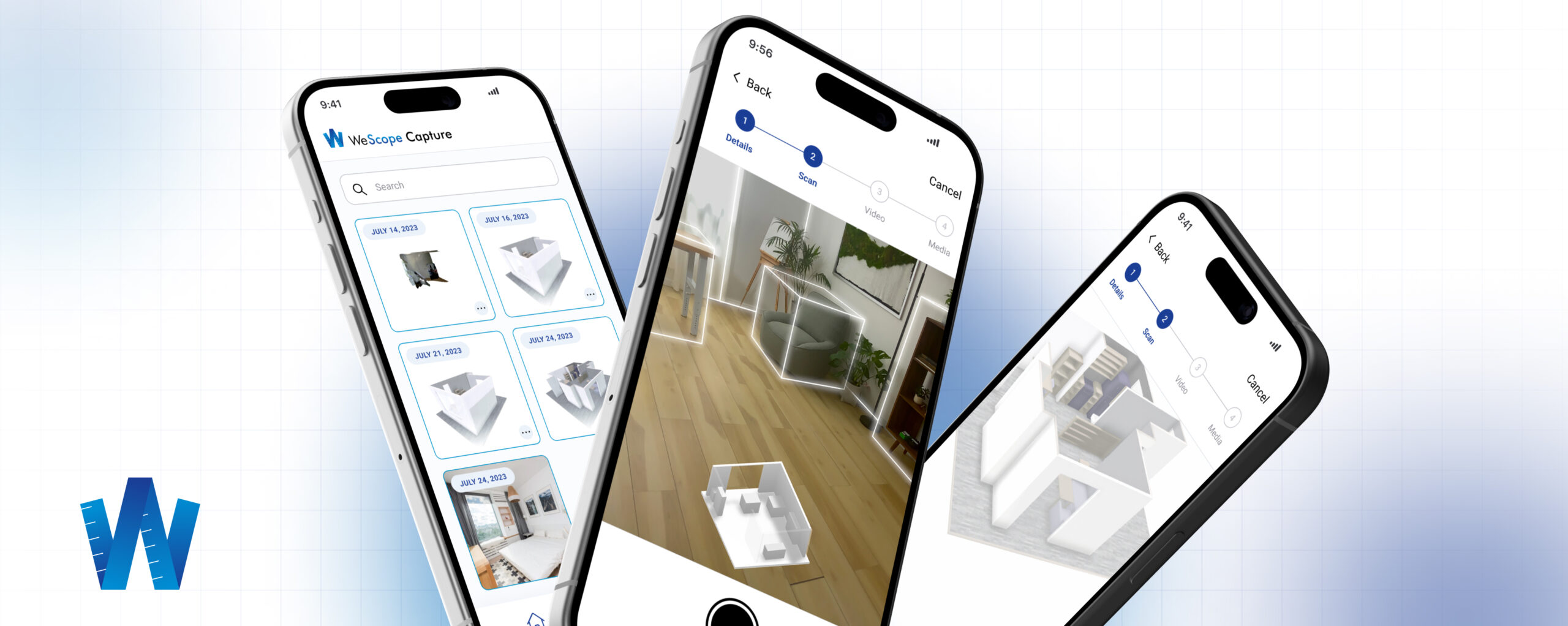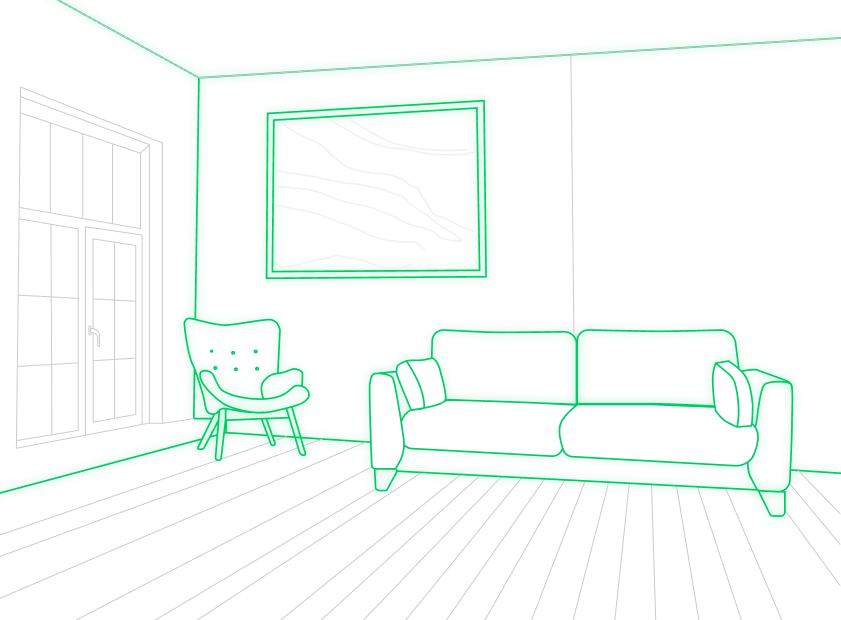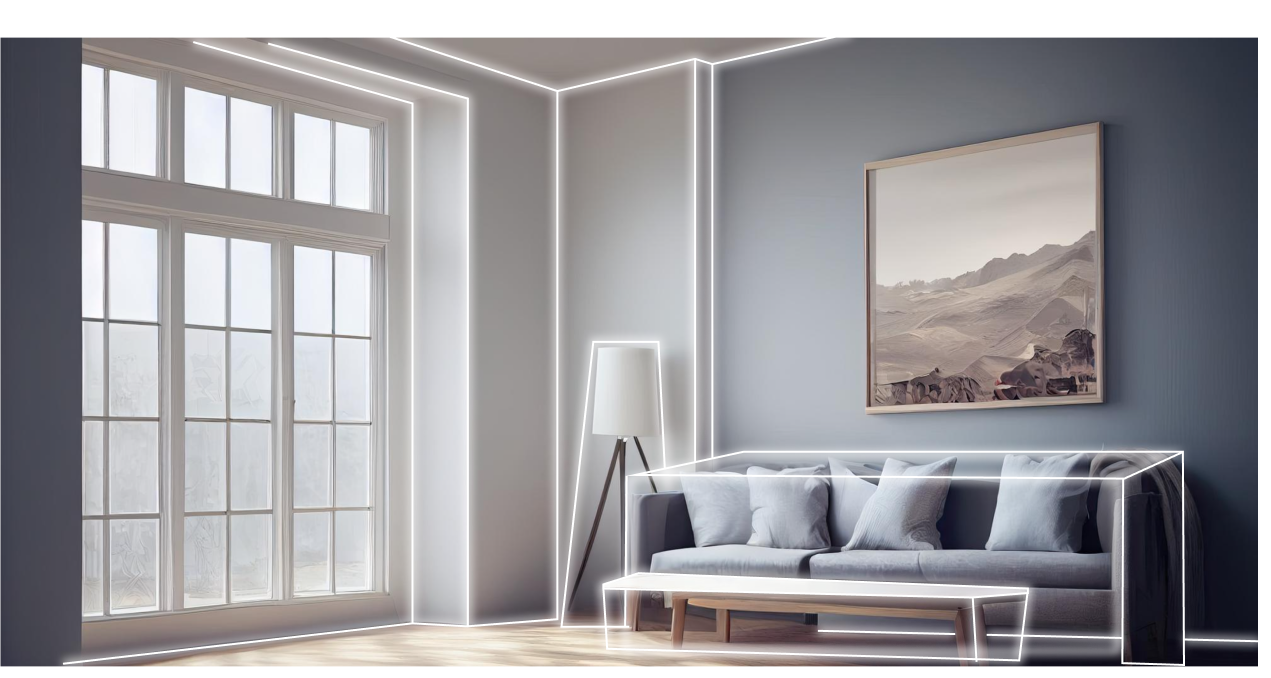
Android, iOS app development

Expertise
Consistently recognized as one of the top software development companies on Clutch, the Volpis team has spent years providing ARKit room plan software development services to craft innovative solutions for businesses across diverse industries. If you’re considering building an AR app, we would be happy to answer all your questions and give honest advice.

AUGMENTED REALITY SOLUTIONS YOU CAN COUNT ON
At Volpis, we use ARKit’s room planning technology to build advanced AR applications. Our developers have extensive experience in creating immersive experiences that blend seamlessly with the real world, enhancing user interactions with virtual elements. With ARKit’s advanced capabilities, our apps on iOS devices provide users with a better sense of how virtual objects fit into their physical space.
We can create a 3D model of a room, which reduces the efforts needed to produce detailed 3D floor plans or prepare new interior designs. This process is particularly useful for real estate agents and interior designers who want to showcase new furniture or lighting conditions in a space. With AR apps, users can visualize how different furniture pieces would look in their rooms, helping them make more informed decisions about their interior design.
Leveraging the measurements obtained through RoomPlan’s room scanning capabilities, we can accurately draw a detailed 2D plan of the room. This feature is particularly useful for real estate agents and developers who need accurate floor plans for marketing purposes. By using AR technology, our apps can generate detailed floor plans quickly and accurately, saving time and effort. With the RoomPlan API, developers can integrate innovative functionality into your augmented reality app, opening up new possibilities for indoor navigation and virtual elements placement.
We can create functionality for saving/sharing/exporting room plan data to the USD file format. This file format describes 3D scenes and allows users to collaboratively work on them across different 3D programs. This capability is beneficial for industries like architecture and interior design, where collaboration on room plans is crucial. With Volpis’s AR development expertise, clients can create immersive experiences that help users navigate complex environments like shopping malls or large office buildings. Our AR applications enable users to determine how virtual objects interact with their real-world environment, making it easier to envision new designs or layouts.

Connecting digital and physical worlds
EXPERTISE
REASONS
Our developers possess full-stack expertise and adeptly craft AR solutions leveraging powerful frameworks such as ARKit, SceneKit, RoomPlan, Metal, and RealityKit. With a deep understanding of augmented reality technologies, we tailor solutions to suit your specific needs, ensuring seamless integration with your existing systems and processes. This approach guarantees a smooth development process and a final product that exceeds your expectations. Our developers stay updated with the latest advancements in AR technology, ensuring that your solutions are always cutting-edge and future-proof.
Don’t hesitate to reach out whenever you need assistance. At Volpis, we emphasize efficient and timely communication to facilitate successful collaboration. Engage directly with our team to explore project details and receive prompt updates, as well as essential information about your AR app. Our team is dedicated to providing you with the best possible service, and we are committed to ensuring that your project is completed on time and within budget. With our team of experts by your side, you can be confident that your project is in good hands.
Our goal is to create top-notch augmented reality products utilizing the RoomPlan framework. We maintain rigorous quality standards throughout the entire project lifecycle. This dedication guarantees meticulous attention to detail, optimizing every line of code, feature, and interaction for superior performance and user satisfaction—from project initiation to final deployment. Our expertise in custom AR app development allows us to tailor our services to meet your specific needs, ensuring that you receive a product that is perfectly suited to your requirements.
Our proficient team combines technical prowess with creative ingenuity to design immersive AR room scanning experiences, seamlessly merging the digital and physical realms. Whether it’s creating a 3D floor plan of a room, complete with key characteristics like dimensions and types of furniture, our expertise fuels inventive solutions that captivate and inspire. From indoor navigation systems to product visualization tools, we have the expertise to turn your ideas into reality. Our commitment to innovation means that we’re always exploring new technologies and techniques to deliver the best possible custom solution for your business.
AUGMENTED REALITY DEVELOPMENT TOOLS
Developing secure, reliable, and seamlessly working custom AR apps requires a good set of innovative technologies for web and mobile app development. Volpis uses leading technology and tools to ensure the highest quality of your AR app.
our work
Explore projects that showcase our expertise in this area, providing real-world examples of our capabilities and success stories.

Android, iOS app development
Our commitment to excellence is reflected in the glowing reviews from our clients, who consistently praise our dedication to delivering exceptional results. It’s been a great honor to provide app development services to our esteemed customers.
“The CEO is very responsive and there are no unnecessary middlemen involved.”
Co-Founder, Health Startup
“I was blown away by the knowledge and skillset that the team possessed.”
Founder, Fit Society LLC
“Volpis was able to consistently deliver against our project milestones.”
Jason Marvel, CEO FlowMSP
Questions & Answers
Apple’s ARKit is a development framework that allows developers to create augmented reality experiences for iOS devices. With ARKit, developers can integrate augmented reality into their apps, enhancing the user experience by overlaying digital content onto the real world. This technology leverages the camera and sensors to track the device’s position and enable realistic AR experiences.
ARKit is supported on a wide range of iOS devices, including iPhones and iPads. The framework takes advantage of the advanced camera and sensor capabilities of these devices to deliver high-quality augmented reality experiences. By utilizing ARKit, developers can create AR apps that cater to a broad audience of iOS users, ensuring a seamless and engaging AR experience across different devices.
ARKit stands out as a premier choice for AR development due to its robust, notable features and seamless integration with iOS devices. Unlike other AR development platforms, ARKit provides developers with advanced tools for scene recognition, image recognition, and spatial mapping, allowing for more immersive and interactive AR experiences. Additionally, ARKit’s compatibility with various iOS devices ensures a wide reach and accessibility for users, making it a superior choice for creating AR apps.
ARKit works by utilizing the camera and sensors of iOS devices to track the position of the mobile device and its orientation in the real world. It also detects horizontal surfaces, such as floors and tables, to anchor digital content in the physical environment. By combining camera images with motion sensor data, ARKit can create a virtual representation of the real world, enabling developers to overlay digital objects seamlessly and create immersive AR experiences.
Creating a room layout with ARKit involves utilizing its capabilities for spatial mapping and scene recognition. Developers can use ARKit to scan the environment and detect walls, floors, and other objects in the room. By leveraging ARKit’s tools for object placement and manipulation, developers can then add virtual furniture and other elements to create a realistic room layout. This process allows users to visualize how furniture and decor will look in their space, making it ideal for interior design and real estate applications.
Augmented reality (AR) is a technology that overlays digital content onto the real world, enhancing the user’s perception of their environment. AR uses devices like smartphones or AR glasses to blend digital objects, such as 3D models or information overlays, with the physical world. This technology allows users to interact with virtual elements in a real-world context, opening up new possibilities for gaming, education, shopping, and more.
Apple Roomplan is a feature within ARKit that allows developers to create apps for planning and visualizing room layouts. With Apple Roomplan, developers can leverage ARKit’s spatial mapping and scene recognition capabilities to create virtual representations of rooms. Users can then interact with these representations to place furniture, decor, and other objects, allowing them to visualize and plan their physical space in a digital environment.
Image recognition is a technology that allows computers to identify and interpret images. With image recognition, computers can analyze the contents of an image and recognize objects, patterns, or text within it. This technology is often used in AR applications to enable object recognition and tracking, allowing digital content to interact with real-world objects and surfaces.
SLAM (Simultaneous Localization and Mapping) and visual inertial odometry are both techniques used in AR to track the position and orientation of a device in the real world. SLAM works by mapping the environment and tracking the device’s position relative to that map, while visual-inertial odometry uses visual and inertial sensor data to estimate the device’s motion.
An AR immersive experience is an augmented reality experience that fully immerses the user in a digital environment. In an AR immersive experience, digital content is seamlessly integrated into the user’s surroundings, creating a sense of presence and interaction with virtual objects. This type of AR experience is often used in gaming, education, and training applications to provide users with a highly engaging and interactive experience.
The main difference between virtual reality (VR) and augmented reality (AR) experiences is the level of immersion and interaction with the virtual environment. In VR, users are fully immersed in a digital environment and typically interact with it using specialized VR headsets and controllers. In contrast, AR overlays digital content onto the real world, allowing users to interact with virtual objects in a real-world context using devices like smartphones or AR glasses. AR enhances the user’s perception of the real world, while VR creates a completely virtual environment.
Improving an AR app’s performance involves optimizing various aspects of the app, such as rendering, tracking, and interaction. Developers can improve rendering performance by optimizing 3D models and textures, reducing the number of polygons and the size of textures. They can also improve tracking performance by optimizing sensor data processing and using advanced tracking algorithms. Additionally, optimizing interaction performance involves ensuring smooth and responsive user interactions, such as object placement and manipulation. By optimizing these aspects, developers can enhance the overall performance and user experience of their AR apps.
GET IN TOUCH